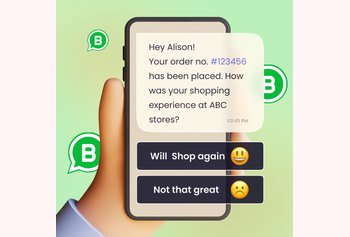How To Deliver Great Customer Service: 10 Tips with Real-Life Examples

Table of contents
When you hear “great customer service,” what’s the first thing that comes to your mind? For me, it’s the personification (or not) of great customer service by Janet, an all-knowing entity that helps residents in The Good Place.
While this sets the bar quite high for memorable service, great customer service is more than just about being memorable—it’s about creating positive, lasting impacts on customers and driving serious business outcomes.
Delivering great customer service is no longer a good-to-have, but a key differentiator for customers. It not only enhances customer satisfaction but also boosts loyalty, retention, and overall business growth.
In this blog, we’ll explore ten actionable tips to deliver great customer service, along with some real-life examples to inspire your customer service strategy.
Table of Contents
10 Tips to Deliver Great Customer Service
1. Personalize Your Interactions
Imagine if that big billboard on your way to work specifically had your name and the exact features of a product you are looking for. I know it sounds Black Mirror-grade dystopian, right? But one thing that it’d definitely do is grab your attention.
That’s the power of personalization. Nothing gets our attention like something tailored to our needs. Personalization makes customers feel valued and understood, fostering loyalty and satisfaction. Customers appreciate it when businesses remember their preferences and treat them as individuals. This creates a more intimate and effective customer relationship, enhancing the overall customer experience.
This is where you can use customer data to tailor interactions. For instance, Starbucks’ personalized rewards program remembers your favorite drinks and offers. Similarly, implementing CRM systems can help you track your customers’ preferences and purchase history, allowing for more personalized service.
Then comes training your staff to recognize and use customer information to personalize interactions meaningfully. It’s not just about dropping your customers’ names in emails. It’s about understanding your customer better with data and using that data to create a tailored experience.
2. Utilize Customer Feedback
Any product that you build is there to solve your customers’ problems. It only makes sense to let their voice lead the innovations in your product.
Listening to feedback helps you understand customer needs and improve your services. It shows customers that their opinions matter and can lead to developments that enhance their experience. Feedback is a crucial component of continuous improvement and can highlight areas that need attention.
Regularly collect and analyze feedback through surveys or direct interactions. Apple’s feedback system drives its product enhancements based on user input, which we will discuss at length later in the article. Act on the feedback by making visible changes and communicating these improvements to customers. Nothing screams great customer service louder than a business that understands, values, and acts on customer feedback.
Here are some tips on how you can get started with collecting and working on customer feedback:
- Create a Feedback Loop: Regularly survey customers to gather their opinions and suggestions. You can use tools like SurveyMonkey to collect and analyze feedback efficiently.
- Act on Feedback: Implement changes based on feedback and inform customers about these improvements. Some feedback cannot be implemented, but that does not mean you should leave your customers hanging.
Reach out to them with reasoning as to why certain things can’t be implemented at the moment and what you will be doing instead to solve their concern. This shows that you listen and care about their experience.
3. Empower Your Employees
Empowered support professionals can make quick decisions to resolve issues, enhancing customer satisfaction. It boosts their morale and makes them more engaged in providing excellent service. Empowerment leads to a more responsive and flexible customer service approach, which will directly improve the customer experience.
Allow employees the authority to solve problems without needing manager approval. Ritz-Carlton does a fabulous job of delivering great customer service, which we will understand in-dept later in the article. One of them is the fact that they empower staff members with a $2,000 allowance to delight guests—ensuring that their staff is equipped to go above and beyond to deliver great customer service.
To mirror this, you can provide training and resources so employees feel confident in making decisions. Establish clear guidelines and trust your staff to act in the customers’ best interests. Say one of your customers is receiving an order quite late, and they are unhappy with it. Is there a way to make it up to the customer? Maybe a freebie, a discount coupon, or something from their purchase history could be a token of their patience and appreciation.
4. Leverage Technology
Technology is spearheading in a lot of industries, and customer service is not an exception. The right tech-stack can allow for quick resolutions and better resource management. With advancements in AI and automation, businesses can handle higher volumes of customer interactions without compromising on quality.
Many businesses have adopted technology and employ customer service platforms to help their support staff with customer queries. This not only improves the efficiency of the team but also helps measure their performance, utilize features that are built to assist support teams, and collaborate easily.
Out of all the tips on this list, using a customer service platform is one that is sure to give instant results. For instance, Flexport, a freight forwarding and customs brokerage company based in California—was able to save 387 months every month and respond 50% faster to their customers with Hiver.

5. Be Proactive
You probably get SMS and emails from your bank when, say, their app is soon to go under maintenance. If you didn’t receive them and suddenly had a whole day where your bank app wouldn’t work, you’d definitely be much more dissatisfied with the business.
This is proactive customer service. If you are aware of a certain problem that could arise, communicating it proactively can help you deliver much better customer service.
It also shows that you anticipate their needs and care about their experience. Proactive support can turn potential problems into positive interactions, increasing customer trust in your business.
You can use data to anticipate problems and notify customers in advance. For example, Netflix informs users of account issues before they disrupt service. To do this, regularly review customer interactions to identify and address recurring issues. Develop systems to monitor customer activity and proactively offer solutions before issues escalate.
- Monitor Customer Activity: Use analytics tools to track customer behavior and identify potential issues before they arise. If, say, your engineering team identifies a bug that needs to be fixed, reach out to your customers and let them know what needs to be fixed, by when, and if there will be any issues that customers might have to face because of it.
- Preemptive Communication: Reach out to customers with potential issues before they contact you. For example, if a delivery is delayed, always inform the customer proactively and offer solutions. Remember, clear, honest communication is a thumb-rule of great customer service.
6. Offer Multi-Channel Support
Providing support across various channels ensures accessibility for all customers. It meets customers where they are, making it convenient for them to seek help. Multi-channel support enhances the customer experience by offering flexibility in communication methods.
Integrate customer service across social media, email, and phone, like Sephora, that offers a seamless experience across multiple platforms. Ensure that your support team is trained to handle inquiries from all channels effectively. Use a unified customer service platform, like Hiver, to manage multi-channel interactions, ensuring consistency and speed in responses.
7. Ensure Quick Response Times
Speed is crucial in customer service. Fast responses lead to higher customer satisfaction. It reduces the frustration of waiting and resolves issues promptly, which can significantly enhance customer loyalty.
Prioritize customer inquiries and streamline processes. How long does it take to respond to customer queries on average? Can your queries be divided into levels? Say L1 (level 1) queries can be resolved quickly by a chatbot. Level 2 might need more time and human intervention, and so on.
Creating these buckets can help you bring down your response time and monitor each bucket properly. Additionally, using tools like Hiver can help get the data you need to continually track and monitor your support team’s progress.
Here are some more ways to bring down the response time to deliver great customer service:
- Automate Initial Responses: Use automated emails to acknowledge customer inquiries immediately, informing them of expected response times.
- Prioritize Urgent Queries: Implement a triage system to prioritize urgent customer issues, ensuring they are addressed promptly. This means accessing and routing your queries to the most-equipped support professional as they come so that your customers get the response they need faster.
8. Provide Self-Service Options
Except for when they are dining at restaurants, most customers absolutely love self-service options. And why wouldn’t they? Self-service options help you resolve your queries without calling the customer service team or writing them an email.
Self-service tools empower customers to resolve issues independently, saving time. A win-win situation for both the support teams and the customers.
Self-service options, like a knowledge base can enhance customer satisfaction by providing quick and easy solutions. Include FAQs, tutorials, and troubleshooting guides in your self-service options. Regularly update self-service content to ensure it remains relevant and helpful.
Many customer service platforms, like Hiver, also offer built-in knowledge base features that let you create and update your knowledge base easily and efficiently.
Learn how to create the perfect knowledge base in just 8 steps.
9. Follow Up After Resolutions
Customer service is not a set-it-and-forget-it function. Great customer service stems from the idea that you wish to create genuine human connections. This is why simply resolving an issue is not the last step in customer service.
How do you know if it worked? Has it truly helped the customer? Did they feel valued and helped after the interaction? You can answer all these questions when you follow up with a customer.
Following up shows you care about the customer’s experience and ensures the issue is resolved. It builds trust and demonstrates a commitment to customer satisfaction. Follow-ups can also help gather additional feedback on the resolution process.
Some ways to get started with this:
- Automate Follow-Ups: Use CRM systems to automate follow-up emails or calls after resolving issues, ensuring consistent follow-through.
- Personalize Messages: Remember to add tip #1, personalization, to the mix and craft meaningful follow-up messages that show you care about your customer. Remember, it’s not just another query in the queue; it’s a person looking for help.
10. Foster a Customer-Centric Culture
A customer-centric support team is not enough to deliver great customer service. A business is a collection of all of its departments. From marketing to product, every department truly needs to be customer-obsessed to deliver outstanding customer service.
Say your support team has input on what features to build next since they interact with customers daily. If your product team does not fall into the customer-centric bucket, all these inputs will never be heard or implemented.
A customer-focused culture enhances service quality and drives loyalty. It aligns the entire organization with the goal of providing excellent service. A strong customer-centric culture can differentiate your brand and create long-term customer relationships.
Ensure that customer-centric values are ingrained in the fabric of your business. Company leaders must be vocal advocates of customer-centricity. Encourage a mindset where every team member understands and values the importance of customer service.
Real-Life Examples of Great Customer Service
1. Apple
Today, Apple holds a massive market share in the smartphone sector. But this was not the case back in 2008-2010, when BlackBerry was dominating the industry.

Breaking customer patterns is not easy, and BlackBerry and Android both held massive chunks of the customer pool back in the day. So, how did the former underdog beat these odds?
The answer lies in great customer service. Apple consistently put customer feedback at the heart of its product development and service improvement processes. This feedback is meticulously analyzed and incorporated into product updates and new features.
For instance, the introduction of features like Face ID and Animoji, as well as the seamless integration of hardware and software, were all influenced by understanding customer desires and pain points.
Apple also anticipates what customers might want before they even realize it themselves, leading to innovations that set industry standards today. Their devotion to maintaining a customer-centric approach has not only helped them capture the largest market share of smartphones in several regions but also generated significant revenue.
In 2023 alone, Apple’s iPhone revenue surpassed $380 billion, which is almost 50 times its revenue back in 2004. Great customer service sure does pay off, right?
Key Takeaways:
1. Act on Customer Feedback: Regularly gather and analyze customer feedback to guide product development and service improvements.
2. Anticipate Customer Needs: Look beyond current feedback to predict future customer desires and innovate accordingly.
3. Consistent User Experience: Maintain a consistent and intuitive user experience to build customer loyalty and satisfaction. Apple maintains its clear and neat UI with iOS, which is clutter-free and sophisticated, making it hard for its customers to switch to anything else once they use Apple’s ecosystem.
2. Zappos
Zappos is known for its exceptional customer service and company culture, which prioritizes customer satisfaction. One well-documented example involves a customer who was unable to return a pair of shoes in time due to her mother’s passing.
When Zappos learned about the situation, they not only accepted the return but also arranged for a courier to pick up the shoes and sent the customer a bouquet of flowers with their condolences. This level of empathy and customer care has become a hallmark of Zappos’ service philosophy.
Zappos empowers its customer service representatives with the autonomy to make decisions that benefit the customer. This means employees can go to great lengths to ensure customer satisfaction without needing managerial approval—a fine proof of its customer-centric culture.
This approach has resulted in strong customer loyalty and positive word-of-mouth marketing, significantly contributing to Zappos’ growth and success. In fact, about 75% of its purchases come from returning customers. The company’s commitment to customer service is a core reason it maintains high customer retention rates and a loyal customer base.
Key Takeaways:
1. Empower Employees: Allow staff to make decisions that benefit the customer, enhancing satisfaction and loyalty.
2. Empathy in Service: Train employees to handle sensitive situations with empathy and care. Customer queries need to be looked at as a way to create meaningful relationships with your customers.
3. Customer-Centric Policies: Implement policies that prioritize customer needs and convenience.
3. Ritz-Carlton
When you think of 5-star hotels, Ritz-Carlton is sure to pop up in your head. And rightfully so.
Ritz-Carlton’s legendary customer service is built on its philosophy of empowering employees to go above and beyond for their guests. One famous example is the case of a young boy who left behind his beloved stuffed giraffe, “Joshie,” at a Ritz-Carlton hotel. The staff not only found Joshie but also took photos of the stuffed animal enjoying various hotel amenities, such as lounging by the pool and getting a massage at the spa. They sent these photos along with Joshie’s return package, delighting the boy and his family:

This level of personalized service creates memorable experiences that turn guests into loyal customers. And make for some really sweet and heartwarming pictures—only an added bonus!
Additionally, Ritz-Carlton empowers its employees with a significant budget to resolve guest issues and create exceptional experiences without needing managerial approval. This policy ensures swift problem resolution and allows staff to make guests feel genuinely valued. Such dedication to customer service has helped Ritz-Carlton maintain a stellar reputation in the hospitality industry, leading to high occupancy rates and a loyal customer base.
Key Takeaways:
1. Personalize Service: Tailor services to individual customer needs to make them feel valued and appreciated. Every customer is different and has different needs—try to identify and cater to them.
2. Create Memorable Experiences: Go above and beyond to create unique and memorable interactions that foster customer loyalty. Shep Hyken, a customer service visionary, discusses some great ways to create memorable experiences on the Experience Matters podcast. Check it out here.
Final Thoughts
Delivering great customer service is more than just resolving issues—it’s about creating memorable experiences that foster loyalty and drive business growth. Apple, Zappos, and Ritz-Carlton show us that a customer-centric approach, driven by personalization, empathy, and innovation, can set a business apart.
By personalizing interactions, acting on feedback, empowering employees, and leveraging technology, you can elevate your customer service to new heights. Remember, every interaction is an opportunity to build a lasting relationship. Embrace these principles, and watch your business transform satisfied customers into loyal advocates.

































